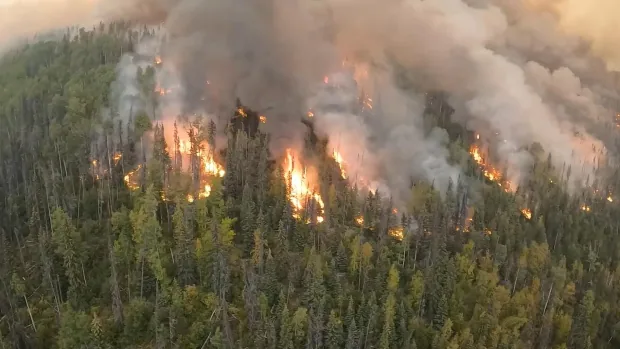More than 1,000 people and major hydro dams under evacuation orders as wildfires cloak much of B.C. in smoke
More than a thousand people have been ordered out of their homes as a number of uncontrolled wildfires burn across B.C., with the flames looming over critical power infrastructure and leaving a haze of wildfire smoke over much of the province.
The largest wildfire of note is Battleship Mountain in the province’s northeast which, as of Monday afternoon, was estimated to be 280 square kilometres — an area larger than the City of Kelowna.
The lightning-caused fire prompted an evacuation order for the entire community of Hudson’s Hope, approximately 360 kilometres northeast of Prince George, on Saturday night. Emergency Management B.C. says in total, 1,032 people in the area have been ordered to leave their homes.
Further south, blazes east and west of Hope have also prompted evacuation orders and alerts, as well as the closure of eastbound lanes of Highway 1.
In all, 162 active wildfires are burning across the province, and air quality advisories remain in effect for much of B.C.
Evacuation order covers ‘critical’ dams
In Hudson’s Hope, evacuees have been directed to a reception centre in the nearby community of Fort St. John, where they can seek supplies and a place to stay.
Hudson’s Hope Mayor Dave Heiberg says residents understand the situation and hope their homes will be protected as the Battleship Mountain wildfire moves closer to the community, which B.C. Wildfire says is now about 12 kilometres away from the district’s edge.
Wildfire spokesperson Sarah Hall said teams had “huge success” in controlling the fire through controlled burns, but with wind and sun forecast for the rest of the week, it is too soon to know how soon people might be allowed to return to their homes.
The evacuation order also covers B.C. Hydro’s Peace Canyon and W.A.C. Bennett dams, which are part of the infrastructure responsible for generating 38 per cent of the utility’s output each year.
“These dams and their generating stations are critical public infrastructure. Given this, both facilities will continue to be operated with limited staff,” B.C. Hydro said in a statement.
The organization said it is also possible to operate the dam remotely, should it become necessary.
“B.C. Hydro has well-established plans to support the reliable supply of power to the province should the fire risk change to either the generation or transmission system.”
Highway 1 closed
Blazes west and east of Hope, B.C., have prompted evacuation orders and alerts, as well as the closure of the eastbound lanes of Highway 1.
A five-square kilometre fire has been burning near the highway between Chilliwack and Hope, with the flames running through steep terrain, making it challenging for crews, officials said.

“Due to hot, dry conditions, increased fire behaviour will be visible today,” read a notice from the B.C. Wildfire Service. “[But] our temperatures should be lower today toward seasonable norms and a chance of light showers on Tuesday and Wednesday.”
Air quality still poor
Environment Canada is maintaining air quality statements for areas from the Peace River in the northeast to the Cariboo in central B.C. and the entire southern third of the province.

The federal government’s air quality index shows areas with the highest levels of potentially dangerous wood smoke include Cranbrook and Castlegar in southeastern B.C., the eastern Fraser Valley and the communities of Whistler and Squamish.
Wildfires in B.C., Washington, Oregon and Idaho are being blamed for the smoke.
Air quality improved in Metro Vancouver on Monday after poor conditions over the weekend.


